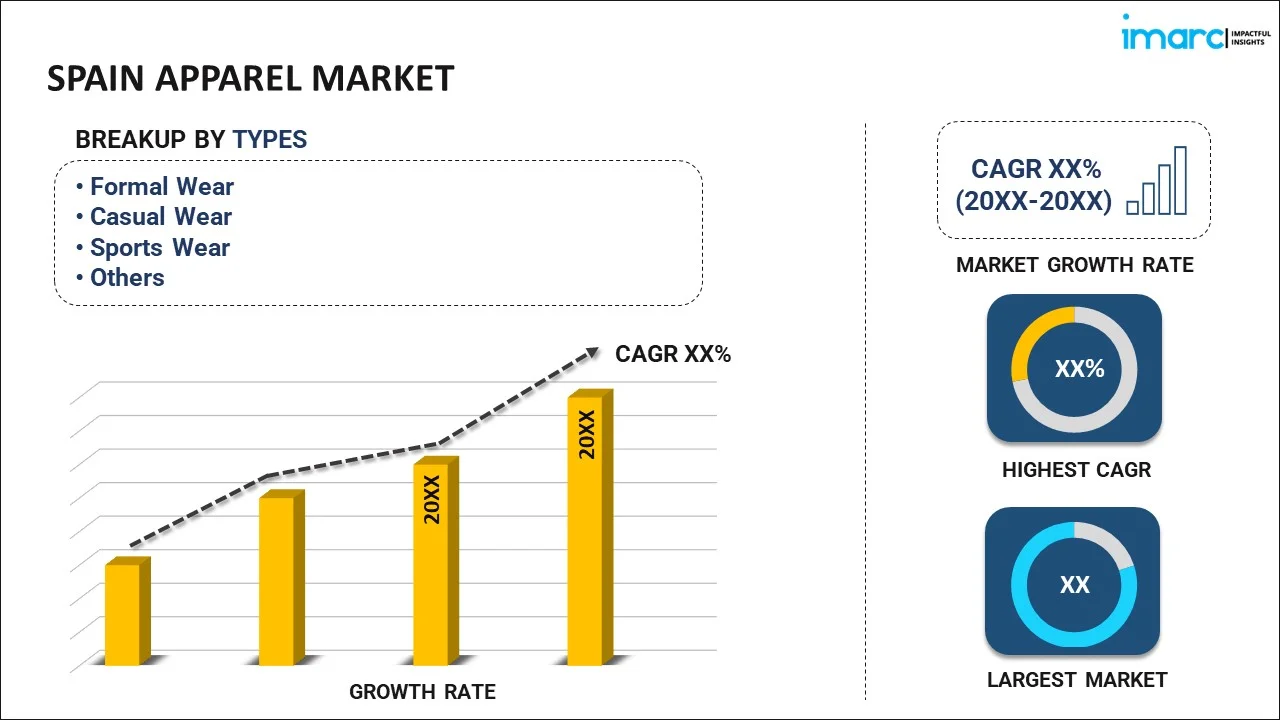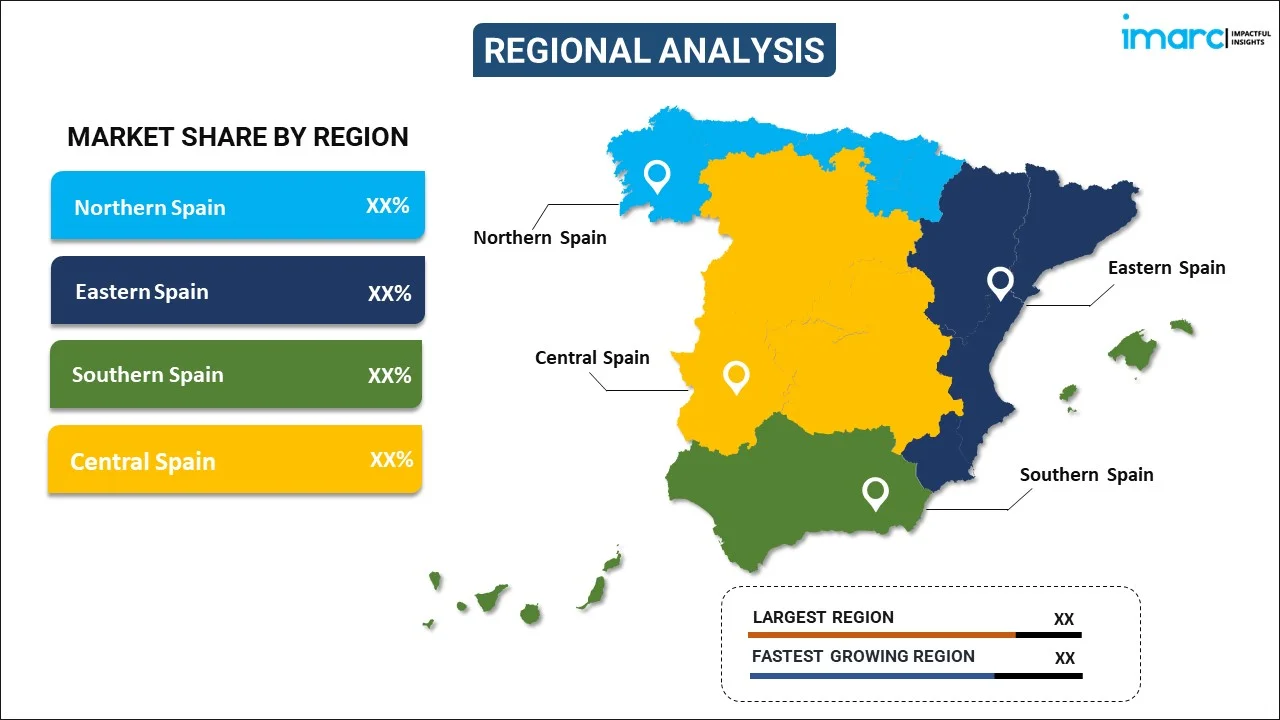
Spain Apparel Market Report by Type (Formal Wear, Casual Wear, Sports Wear, Safety Wear, and Others), Distribution Channel (Online, Offline), End User (Men, Women, Kids), and Region 2026-2034
Spain Apparel Market Overview:
The Spain apparel market size reached USD 20.5 Billion in 2025. Looking forward, IMARC Group expects the market to reach USD 28.0 Billion by 2034, exhibiting a growth rate (CAGR) of 3.52% during 2026-2034. The rising disposable incomes, increasing fashion consciousness, significant e-commerce expansion, a growing preference for sustainable clothing, and the influence of international fashion trends represent some of the prime factors bolstering the market growth.
|
Report Attribute
|
Key Statistics
|
|---|---|
|
Base Year
|
2025
|
|
Forecast Years
|
2026-2034
|
|
Historical Years
|
2020-2025
|
|
Market Size in 2025
|
USD 20.5 Billion |
|
Market Forecast in 2034
|
USD 28.0 Billion |
| Market Growth Rate 2026-2034 | 3.52% |
Access the full market insights report Request Sample
Spain Apparel Market Trends:
Rise of fast fashion
Spanish brands like Zara and Mango have pioneered the fast fashion model, which focuses on quickly bringing the latest trends from the runway to retail stores. This model caters to consumers' desire for trendy, affordable clothing that can be frequently updated, leading to higher turnover rates and increased sales. Fast fashion companies leverage efficient supply chain management and advanced manufacturing technologies to produce new collections rapidly and at lower costs. This trend has made fashion more accessible to a broader audience, propelling the growth of the apparel market in Spain. In addition to this, customers enjoy the thrill of continuously updating their wardrobes with the newest styles since they are used to frequent new arrivals, which is also contributing to the market expansion.
Growing demand for sustainable and ethical clothing
There is a growing demand for sustainable and ethical clothing driven by increased consumer awareness of environmental and social issues. Shoppers prioritize brands that champion sustainability, fair labor, and ethical sourcing, leading to a rise in eco-friendly materials like organic cotton and recycled fabrics. Brands respond with transparent supply chains, eco-friendly production, and sustainable product lines, catering to ethically-minded consumers and standing out in a competitive market. Retailers highlight sustainability efforts to reduce carbon footprints and support ethical manufacturing. For instance, Lenzing partnered with TWOTHIRDS to launch a collection featuring garments made from LENZING™ ECOVERO™ fabric, blending sustainability and style. ECOVERO™ offers eco-friendly, biodegradable material, aligning with TWOTHIRDS' goal of promoting environmentally conscious fashion. This collaboration highlights the industry's commitment to sustainable practices and educates consumers about sustainable textile options, driving further change towards a more eco-conscious fashion landscape.
E-commerce and digitalization
The ease of shopping online, along with advancements in digital technology, has transformed the way that consumers buy clothes. Customers find e-commerce platforms appealing as they provide a large selection of goods, affordable prices, and the convenience of home shopping. Mobile commerce is growing, with many shoppers using smartphones and tablets to browse and buy apparel. By early 2023, Spain had 45.12 million internet users (94.9% penetration), 40.70 million social media users (85.6% penetration), and 58.32 million active cellular mobile connections (122.7% penetration), reflecting high connectivity rates across multiple platforms in the country. Consequently, digital marketing efforts, including social media, influencer collaborations, and targeted advertising are driving online sales and engagement among customers. Moreover, retailers are investing in robust online platforms and integrating omnichannel strategies to seamlessly blend in-store and online shopping experiences to meet consumers' expectations for convenience and flexibility thus aiding in market expansion.
Spain Apparel Market News:
- In March 2024, Spain's Mango clothing chain is boosting its global expansion efforts, aiming to strengthen its international presence. The company plans to open new stores worldwide, enhancing its footprint in key markets and tapping into emerging regions to drive growth and increase brand visibility on a global scale.
- In December 2023, Zara expanded its 'pre-owned' second-hand clothes service to 14 more European countries, including Spain and Germany, in response to the growing used apparel market.
Spain Apparel Market Segmentation:
IMARC Group provides an analysis of the key trends in each segment of the market, along with forecasts at the country level for 2026-2034. Our report has categorized the market based on type, distribution channel, and end user.
Type Insights:

To get detailed segment analysis of this market Request Sample
- Formal Wear
- Casual Wear
- Sports Wear
- Safety Wear
- Others
The report has provided a detailed breakup and analysis of the market based on the type. This includes formal wear, casual wear, sports wear, safety wear, and others.
Distribution Channel Insights:
- Online
- Offline
A detailed breakup and analysis of the market based on the distribution channel have also been provided in the report. This includes online and offline.
End User Insights:
- Men
- Women
- Kids
The report has provided a detailed breakup and analysis of the market based on the end user. This includes men, women, and kids.
Regional Insights:

To get detailed regional analysis of this market Request Sample
- Northern Spain
- Eastern Spain
- Southern Spain
- Central Spain
The report has also provided a comprehensive analysis of all the major regional markets, which include Northern Spain, Eastern Spain, Southern Spain, and Central Spain.
Competitive Landscape:
The market research report has also provided a comprehensive analysis of the competitive landscape in the market. Competitive analysis such as market structure, key player positioning, top winning strategies, competitive dashboard, and company evaluation quadrant has been covered in the report. Also, detailed profiles of all major companies have been provided.
Spain Apparel Market Report Coverage:
| Report Features | Details |
|---|---|
| Base Year of the Analysis | 2025 |
| Historical Period | 2020-2025 |
| Forecast Period | 2026-2034 |
| Units | Billion USD |
| Scope of the Report | Exploration of Historical Trends and Market Outlook, Industry Catalysts and Challenges, Segment-Wise Historical and Future Market Assessment:
|
| Types Covered | Formal Wear, Casual Wear, Sports Wear, Safety Wear, Others |
| Distribution Channels Covered | Online, Offline |
| End Users Covered | Men, Women, Kids |
| Regions Covered | Northern Spain, Eastern Spain, Southern Spain, Central Spain |
| Customization Scope | 10% Free Customization |
| Post-Sale Analyst Support | 10-12 Weeks |
| Delivery Format | PDF and Excel through Email (We can also provide the editable version of the report in PPT/Word format on special request) |
Key Questions Answered in This Report:
- How has the Spain apparel market performed so far and how will it perform in the coming years?
- What is the breakup of the Spain apparel market on the basis of type?
- What is the breakup of the Spain apparel market on the basis of distribution channel?
- What is the breakup of the Spain apparel market on the basis of end user?
- What are the various stages in the value chain of the Spain apparel market?
- What are the key driving factors and challenges in the Spain apparel?
- What is the structure of the Spain apparel market and who are the key players?
- What is the degree of competition in the Spain apparel market?
Key Benefits for Stakeholders:
- IMARC’s industry report offers a comprehensive quantitative analysis of various market segments, historical and current market trends, market forecasts, and dynamics of the Spain apparel market from 2020-2034.
- The research report provides the latest information on the market drivers, challenges, and opportunities in the Spain apparel market.
- Porter's five forces analysis assist stakeholders in assessing the impact of new entrants, competitive rivalry, supplier power, buyer power, and the threat of substitution. It helps stakeholders to analyze the level of competition within the Spain apparel industry and its attractiveness.
- Competitive landscape allows stakeholders to understand their competitive environment and provides an insight into the current positions of key players in the market.
Need more help?
- Speak to our experienced analysts for insights on the current market scenarios.
- Include additional segments and countries to customize the report as per your requirement.
- Gain an unparalleled competitive advantage in your domain by understanding how to utilize the report and positively impacting your operations and revenue.
- For further assistance, please connect with our analysts.
 Request Customization
Request Customization
 Speak to an Analyst
Speak to an Analyst
 Request Brochure
Request Brochure
 Inquire Before Buying
Inquire Before Buying




.webp)




.webp)












